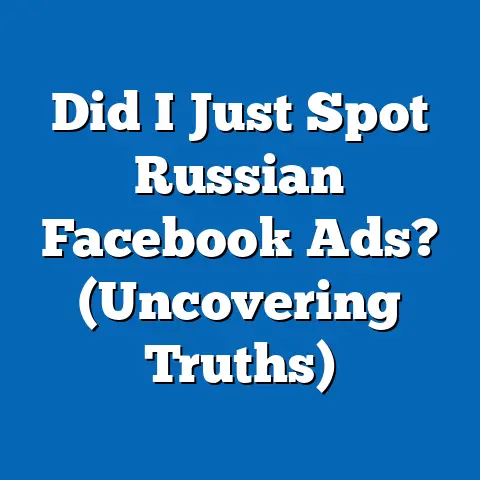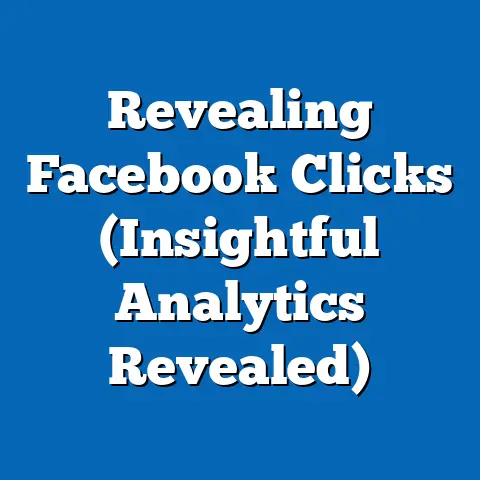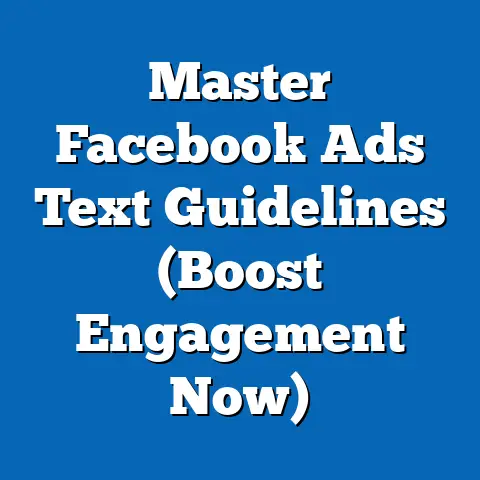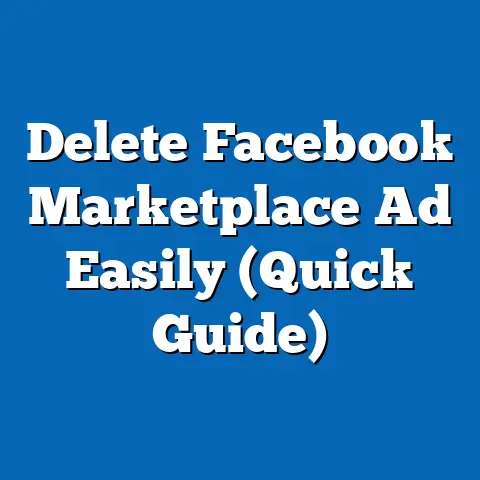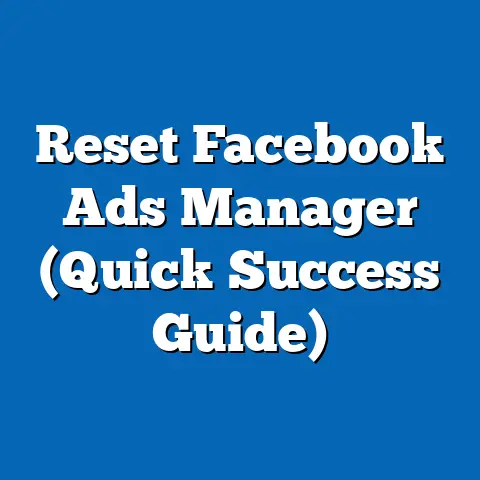Boost ROI with Optimal fb ad Density (Proven Strategies)
Are your Facebook ads truly resonating with your audience, or are they getting lost in the digital noise? I’ve seen countless businesses struggle to maximize their return on investment (ROI) through Facebook advertising. It’s a common problem: you invest time and money, but the results are…meh. The truth is, simply creating ads isn’t enough. You need to understand and optimize your ad density. Finding that sweet spot, that balance between visibility and annoyance, can be the key to unlocking significant improvements in your campaign performance. In this guide, I’ll share proven strategies to help you master Facebook ad density and boost your ROI.
Understanding Facebook Ad Density
So, what exactly is Facebook ad density? It’s not about cramming as many ads as possible into a user’s feed. Instead, it refers to the optimal frequency and placement of your ads. It’s about finding the sweet spot where your ads are visible enough to make an impact, but not so frequent that they become annoying and lead to ad fatigue.
Think of it like this: imagine someone constantly trying to sell you something. After a while, you’d probably start ignoring them, right? The same principle applies to Facebook ads. Too many ads, and people will tune you out. Too few, and you might not even be noticed.
Why does it matter? Because ad density directly impacts your ROI. When done right, it can lead to:
- Increased brand awareness: More people seeing your ads means more people becoming familiar with your brand.
- Higher engagement rates: When your ads are relevant and well-timed, people are more likely to click, like, comment, and share.
- Improved conversion rates: Ultimately, the goal of most Facebook ads is to drive conversions, whether it’s sales, leads, or website traffic. Optimal ad density can help you achieve this.
- Positive brand perception: No one wants to be bombarded with ads. By finding the right balance, you can avoid annoying your audience and maintain a positive brand image.
The Psychology Behind Ad Density
Understanding the psychology behind ad density is crucial. We’re constantly bombarded with information online, and our attention spans are shrinking. This leads to something called “ad blindness,” where we subconsciously filter out ads.
Think about how you scroll through your own Facebook feed. You probably don’t even consciously register most of the ads you see. That’s ad blindness in action.
To overcome this, you need to understand how people consume content on social media. They’re looking for entertainment, information, and connection. Your ads need to fit seamlessly into that experience. They need to be:
- Relevant: Targeting the right audience with the right message.
- Engaging: Capturing attention with compelling visuals and copy.
- Valuable: Offering something of interest or benefit to the user.
By focusing on these elements, you can create ads that are welcomed rather than ignored, even with a higher frequency.
Takeaway: Facebook ad density is about finding the sweet spot between visibility and annoyance. Understanding the psychology behind ad blindness and attention spans is crucial for creating effective campaigns.
The Impact of Ad Density on ROI
I’ve seen firsthand how ad density can dramatically impact ROI, both positively and negatively. It’s not a one-size-fits-all situation; what works for one business might be a disaster for another. That’s why understanding the nuances is so important.
Overexposure: The Road to Ad Fatigue
Let’s start with the downside: overexposure. Bombarding your audience with too many ads can lead to ad fatigue. This happens when people become so used to seeing your ads that they start to ignore them, or worse, develop a negative association with your brand.
I remember working with a client who was launching a new product. They were so excited that they decided to run ads every hour to ensure maximum visibility. The result? Their engagement rates plummeted, their click-through rates tanked, and people started leaving negative comments on their ads. They were essentially annoying their target audience into ignoring them.
Here’s what can happen with overexposure:
- Decreased Engagement: People are less likely to click, like, comment, or share your ads.
- Lower Conversion Rates: If people are annoyed by your ads, they’re certainly not going to buy your product.
- Negative Brand Perception: Overexposure can damage your brand image, making people see you as pushy and intrusive.
- Increased Ad Costs: As engagement rates decline, Facebook’s algorithm will penalize you by increasing your ad costs.
Underexposure: Missing the Opportunity
On the other hand, underexposure can be just as detrimental. If your ads aren’t seen frequently enough, you’re missing out on valuable opportunities to reach your target audience and drive conversions.
I once consulted with a small business that was hesitant to invest in Facebook ads. They ran a few ads here and there, but their frequency was so low that they barely made a dent in their target market. They were essentially whispering when they needed to be shouting.
Here’s what can happen with underexposure:
- Limited Reach: Your ads aren’t seen by enough people.
- Low Brand Awareness: People don’t know who you are or what you offer.
- Missed Opportunities: You’re missing out on potential sales and leads.
- Inefficient Spending: You’re not getting the most out of your advertising budget.
Finding the Sweet Spot
So, how do you find that sweet spot between overexposure and underexposure? It’s all about experimentation and analysis.
I’ve seen successful brands use a variety of ad density strategies. Some focus on running fewer ads with higher budgets, targeting a very specific audience. Others run more ads with lower budgets, casting a wider net. The key is to test different approaches and see what works best for your business and your target audience.
Here are some general guidelines:
- Consider Your Audience: Are you targeting a niche market or a broad audience? The more specific your audience, the more frequently you can show them ads without causing annoyance.
- Think About Your Product: Are you selling a high-consideration product that requires multiple touchpoints before a purchase? If so, you might need to increase your ad frequency.
- Analyze Your Metrics: Pay close attention to your engagement rates, click-through rates, and conversion rates. These metrics will tell you whether your ad density is too high, too low, or just right.
Takeaway: Both overexposure and underexposure to ads can negatively impact your ROI. Finding the optimal ad density requires experimentation, analysis, and a deep understanding of your target audience.
I’m going to share some proven strategies that I’ve used to help businesses optimize their ad density and boost their ROI.Strategy 1: A/B Testing for Frequency
A/B testing is your best friend when it comes to figuring out the optimal ad frequency. I can’t stress this enough: never assume you know what your audience wants. Test, test, test!
Here’s a step-by-step guide on how to conduct A/B tests with various ad frequencies:
- Define Your Goal: What do you want to achieve with your ads? Are you trying to increase brand awareness, drive website traffic, or generate leads?
- Choose Your Metric: What metric will you use to measure the success of your ads? This could be click-through rate, conversion rate, or cost per acquisition.
- Create Two Ad Sets: Create two identical ad sets, targeting the same audience and using the same creative.
- Vary the Frequency: In one ad set, set a lower frequency cap (e.g., one impression per day). In the other ad set, set a higher frequency cap (e.g., three impressions per day).
- Run the Test: Run the test for a week or two, depending on your budget and the size of your audience.
- Analyze the Results: Compare the performance of the two ad sets. Which one achieved your goal more effectively?
- Adjust Your Strategy: Based on the results of the test, adjust your ad frequency accordingly.
Example: Let’s say you’re running ads to promote a new e-book. You create two ad sets, one with a frequency cap of one impression per day and another with a frequency cap of three impressions per day. After a week, you find that the ad set with the higher frequency cap generated more leads at a lower cost per lead. This suggests that your audience responds well to a higher ad frequency.
Takeaway: A/B testing is essential for finding the optimal ad frequency. Experiment with different frequencies and analyze the results to see what works best for your audience.
Strategy 2: Audience Segmentation
Not all audiences are created equal. What works for one segment might not work for another. That’s why audience segmentation is crucial for achieving optimal ad density.
Here’s how to segment your audience and tailor your messaging:
- Identify Your Audience Segments: Divide your audience into smaller groups based on demographics, interests, behaviors, and purchase history.
- Create Tailored Messaging: Craft ad copy and visuals that resonate with each specific segment.
- Adjust Ad Frequency: Adjust your ad frequency based on the characteristics of each segment. For example, you might show ads more frequently to a segment that’s highly engaged with your brand.
Example: Let’s say you’re selling fitness equipment. You might segment your audience into two groups: beginners and experienced athletes. You could show ads with introductory offers and basic workout tips to beginners, while showing ads with advanced equipment and training techniques to experienced athletes. You might also show ads more frequently to the beginners, as they might need more exposure to your brand before making a purchase.
Takeaway: Audience segmentation allows you to tailor your messaging and ad frequency to specific groups, resulting in more effective ads and less ad fatigue.
Strategy 3: Dynamic Creative Optimization
Dynamic creative optimization (DCO) is a powerful tool that allows you to automatically test different combinations of ad elements, such as headlines, images, and call-to-action buttons. This can help you keep your ads fresh and engaging, even with a higher frequency.
Here’s how DCO works:
- Upload Multiple Assets: Upload multiple versions of your headlines, images, and call-to-action buttons.
- Enable DCO: Enable the DCO feature in Facebook Ads Manager.
- Let Facebook Do the Work: Facebook will automatically test different combinations of your assets and show the best-performing combinations to your audience.
Example: Let’s say you’re running ads to promote a new line of clothing. You could upload multiple images of your clothes, different headlines highlighting different features, and various call-to-action buttons like “Shop Now” or “Learn More.” Facebook will then test different combinations of these elements and show the best-performing combinations to your audience, ensuring that your ads are always fresh and engaging.
Takeaway: Dynamic creative optimization can help you keep your ads fresh and engaging, even with a higher frequency, by automatically testing different combinations of ad elements.
Strategy 4: Utilizing Analytics for Continuous Improvement
Optimizing ad density is not a one-time task. It’s an ongoing process that requires continuous monitoring and analysis. You need to keep a close eye on your ad performance metrics and make adjustments as needed.
Here are some key metrics to monitor:
- Frequency: How many times is each person seeing your ads?
- Reach: How many unique people are seeing your ads?
- Engagement Rate: How are people interacting with your ads?
- Click-Through Rate: How many people are clicking on your ads?
- Conversion Rate: How many people are taking the desired action (e.g., making a purchase, filling out a form)?
- Cost Per Acquisition: How much are you spending to acquire a new customer or lead?
By monitoring these metrics, you can identify areas for improvement and adjust your ad density accordingly.
Example: Let’s say you notice that your ad frequency is high, but your engagement rate is low. This suggests that your ads are becoming annoying to your audience, and you need to reduce your frequency or refresh your creative.
Takeaway: Continuous monitoring and analysis are essential for optimizing ad density. Keep a close eye on your ad performance metrics and make adjustments as needed to ensure that your ads are always effective.
Real-World Examples and Case Studies
Theory is great, but seeing these strategies in action is even better. I’ve compiled a few real-world examples of businesses that have successfully optimized their Facebook ad density.
Case Study 1: The E-Commerce Startup
An e-commerce startup selling handmade jewelry was struggling to generate sales through Facebook ads. They were running a high volume of ads with a low budget, resulting in a low frequency and limited reach.
The Solution: They reduced their ad frequency and increased their budget, focusing on targeting a smaller, more specific audience. They also implemented dynamic creative optimization to keep their ads fresh and engaging.
The Results: Their engagement rates increased by 50%, their click-through rates doubled, and their conversion rates tripled. They were able to generate more sales with a smaller budget.
Case Study 2: The Local Restaurant
A local restaurant was trying to attract new customers through Facebook ads. They were running a low volume of ads with a high budget, resulting in a high frequency and ad fatigue.
The Solution: They increased their ad frequency and segmented their audience based on location and interests. They also created tailored messaging for each segment, highlighting different menu items and promotions.
The Results: Their reach increased by 75%, their engagement rates improved by 40%, and their website traffic doubled. They were able to attract more new customers without annoying their existing ones.
Quote from a Marketing Professional: “Optimizing ad density is crucial for achieving a positive ROI on Facebook ads. It’s all about finding the right balance between visibility and annoyance. By testing different frequencies, segmenting your audience, and using dynamic creative optimization, you can create ads that are both effective and engaging.” – Sarah Jones, Digital Marketing Consultant.
Takeaway: These case studies demonstrate the power of optimizing ad density. By implementing the strategies discussed in this guide, you can achieve significant improvements in your campaign performance.
Common Pitfalls to Avoid
Even with the best strategies in place, it’s easy to fall into common traps. I’ve seen these mistakes time and time again, so I want to make sure you’re aware of them.
-
Excessive Frequency Without Relevant Content: This is the biggest offender. Bombarding users with the same generic ad over and over is a surefire way to annoy them. Make sure your ads are relevant, engaging, and offer value.
-
Ignoring Audience Insights: Don’t just guess what your audience wants. Use Facebook’s audience insights tool to understand their demographics, interests, and behaviors. This will help you create more targeted and effective ads.
-
Failing to Monitor and Adjust: As I mentioned earlier, optimizing ad density is an ongoing process. Don’t just set it and forget it. Monitor your metrics and make adjustments as needed.
-
Treating All Audiences the Same: Different audience segments respond differently to different ad frequencies. Don’t assume that what works for one segment will work for another.
-
Overlooking Creative Fatigue: Even with dynamic creative optimization, your ads can become stale over time. Make sure to refresh your creative regularly to keep your audience engaged.
Excessive Frequency Without Relevant Content: This is the biggest offender. Bombarding users with the same generic ad over and over is a surefire way to annoy them. Make sure your ads are relevant, engaging, and offer value.
Ignoring Audience Insights: Don’t just guess what your audience wants. Use Facebook’s audience insights tool to understand their demographics, interests, and behaviors. This will help you create more targeted and effective ads.
Failing to Monitor and Adjust: As I mentioned earlier, optimizing ad density is an ongoing process. Don’t just set it and forget it. Monitor your metrics and make adjustments as needed.
Treating All Audiences the Same: Different audience segments respond differently to different ad frequencies. Don’t assume that what works for one segment will work for another.
Overlooking Creative Fatigue: Even with dynamic creative optimization, your ads can become stale over time. Make sure to refresh your creative regularly to keep your audience engaged.
Takeaway: Avoiding these common pitfalls is just as important as implementing the right strategies. By being aware of these mistakes and taking steps to prevent them, you can maximize your ROI on Facebook ads.
Conclusion: The Path Forward
We’ve covered a lot of ground in this guide. From understanding the psychology behind ad density to implementing proven strategies and avoiding common pitfalls, you now have the knowledge and tools you need to optimize your Facebook ad campaigns.
Remember, mastering ad density is not just an option but a necessity for businesses aiming to boost their ROI on Facebook. It’s about finding the right balance between visibility and annoyance, creating ads that are both effective and engaging.
So, what are the next steps?
- Assess Your Current Ad Density: Take a look at your existing Facebook ad campaigns and analyze your metrics. Are you seeing signs of ad fatigue? Are you reaching enough people?
- Implement the Strategies Discussed: Start experimenting with different ad frequencies, segmenting your audience, and using dynamic creative optimization.
- Monitor Your Results: Keep a close eye on your ad performance metrics and make adjustments as needed.
- Stay Up-to-Date: Facebook’s advertising platform is constantly evolving. Stay informed about the latest features and best practices to ensure that your campaigns are always effective.
By taking these proactive steps, you can achieve your advertising goals and unlock the full potential of Facebook ads. Don’t let your ads get lost in the noise. Take control of your ad density and start boosting your ROI today!

